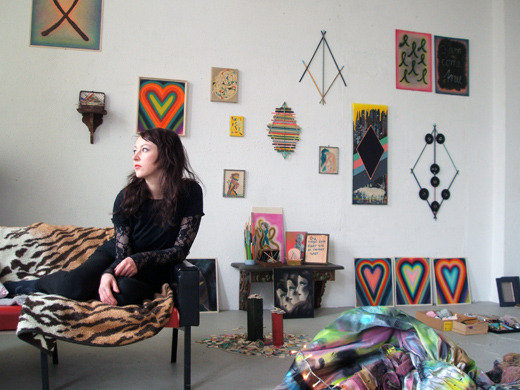Corinne von Lebusa
dal 25/4/2013 al 14/6/2013
Segnalato da
25/4/2013
Corinne von Lebusa
Galerie Jette Rudolph, Berlin
Halt mich, oder halt nicht. The artist features small-scale watercolor paintings done on fragile cardboard. "I will have to find out who is right, society or myself".

“I will have to find out who is right, society or myself” [1]
The Jette Rudolph Gallery is very pleased to present the first Berlin solo show of Leipzig artist Corinne von Lebusa (*1978; Herzberg).
Lebusa’s paintings and exhibition pieces magnetically attract the viewer through the clarity of their color and compositional accents despite the fact that they are small-scale watercolor paintings done on fragile cardboard, a material that in turn calls for the protective housing of a picture frame. In terms of her stylistic repertoire, the artist’s work varies between figuration, abstraction and work that is strictly textual, where brushstrokes formulate gentle, curving forms, and assertive statements that span the entire image such as “Ich bin der Sinn des Lebens” (“I am the meaning of life”) are charmingly communicated to the reader.
With provocative verbal statements and contrast-rich composition and color interplay, Corinne von Lebusa experiments with today’s culture and the phenomenon of showing. Things constantly surface facial expressions, gestures or actions between people which, in an indeterminate pictorial space, demand some type of narrative or logical ordering. Fragmented into what look like scenes or broken up into abstract forms, the various paintings are autonomous projections that aren’t mimetically based on real examples. Instead, they test the viewer’s conditioned gaze and his or her notion of the medium of the painting.
The special emphasis in Lebusa’s works on the act of pointing, which is really what constantly captures the recipient’s attention, is ultimately rooted in the use of gestures. Frequently evoked in her work, these gestures are at the “[origin] of human communication” [2] and today, as an information-carrying sign, play a special role in advertising and the media.
The at times symbolically charged visualization of the act and effect of pointing is created by symbols that include arrows and extended fingers, or by acts of disclosure and concealment in the form of stark nakedness or something hidden behind a scarf, mask or hair. In this way, the artist undermines the stringent causality that might otherwise accompany the act of showing and creates an artificial reality in the painting’s projection field, thereby alienating the things and people that act and appear in the image, “… as if they were traces of that which is shown.” [3]
Corinne von Lebusa loves annoying her viewers and those who read her paintings, and she loves doing this by invoking today’s widespread “picture mythology”, “which in a hymn-like way glorifies the picture as an acting subject…” [4]
By alternating between free abstract or textual forms and traditional representational portraits or collages, Lebusa’s work impressively oscillates between intuition and ratio. In the tension between abstraction and mimesis, between painting and object, the artist’s works move freely in a transcendental area characterized by motif recognition and an emphasis on the means used to create the picture. Unlike figurative or scenic representations, the artist’s abstract form-vocabulary synthesizes in such a way that mental processes are depicted. So by combining signs of emotional states and inner truths with reality-based painting genres, Lebusa is able to construct a visual, aesthetic reality.
With her works, the artist presents subjective images of the world and uses the pictorial space as a place to present fragmentary views of her image of humanity, which can hardly be understood rationally: She raises questions of identity and explores the process of inventing oneself, doing so through themes of femininity, sexuality, philosophy and artificiality. With accents created by: 1) the gentle contours of a sometimes ornamental formal language; 2) the bright colors with their gentle, almost “makeup-like” transitions; 3) and the fragile, abstract, cardboard collages that have been carefully assimilated, these works convey specific notions of femininity that not only have a polarizing, unconventional and honest effect, but a wild, ironic, aggressive and uncompromising one as well, thereby ultimately always opposing the notion of a self-contained system.
In the current exhibition, the compelling scene-like representations of several figures in the room engaged in actions, either together or alongside one another, these increasingly give way to a focus on the following: the individual figure, the autonomous, abstract, winding bands and tubes of color, and simple motif-and-text combinations. In Lebusa’s paintings, dialog and the clear-cut juxtaposition of man and woman powerfully fuse, creating a multi-part, wall-filling portrait series on “… archetypes with faces where the genders blur. It is no longer about man and woman but about being in itself.” [5]
1 Nora Helmer in Henrik Ibsen: Nora oder Ein Puppenheim, 1879.
2 Vgl. Michael Tomasello, Die Ursprünge der menschlichen Kommunikation, 2009.
3 Vgl. Lambert Wiesing, Sehen lassen. Die Praxis des Zeigens, 2013, S. 228.
4 Ebd., S.42.
5 Ebd., S. 76.
6 Lu Potemka zu den Arbeiten der Künstlerin: Ich fühle, also bin ich, 2013 (unpubl.).
Opening: 26. April, 2013, 18:00-22:00 Uhr
Galerie Jette Rudolph GmbH
Strausberger Platz 4, D- 10243 Berlin
open: Tues- Sat 12.00 am- 6 pm



